Women’s Fashion in the 1950’s
After the poor, low-supplied Great Depression and WWII of the 1930’s and 40’s, the 1950’s brought on a new wave of comfortability and therefore more attention and money able to be spent on fashion. While the looks mirrored the conservative, gender-conforming times in terms of their femininity, they were also full of glamour, with icons like Marilyn to mimic. The key look of the 50’s was the cinched waist and accentuated curves, adding and emphasizing classic femininity. However, more casual clothing also began to appear slowly and steadily such as pants, shorts, or sleeveless dresses.
Even though dresses and skirts stayed the main form of bottoms for girls and women, high-waisted pants that were cinched tight at the waist also were becoming prominent pieces.
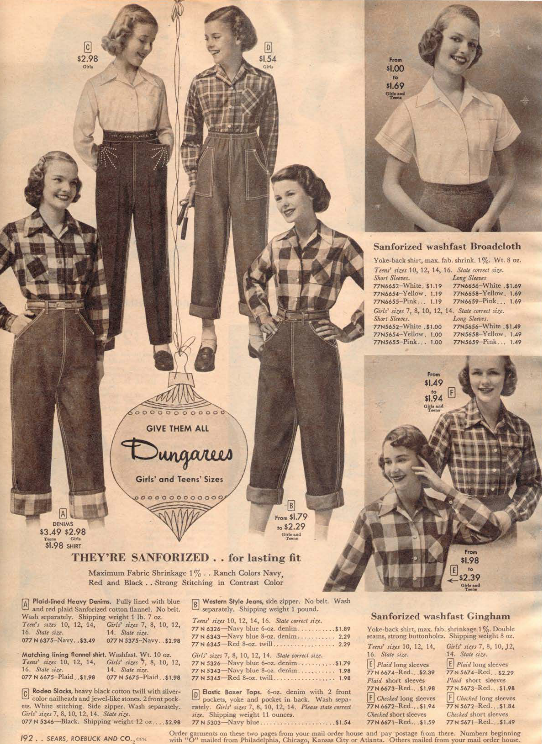
(1953 Sears Catalogue)
In 1947, Christian Dior introduced the “New Look” which would define the foundations for 1950’s women’s fashion. It included influences from the mid 19th century with a full skirt and pronounced bust.
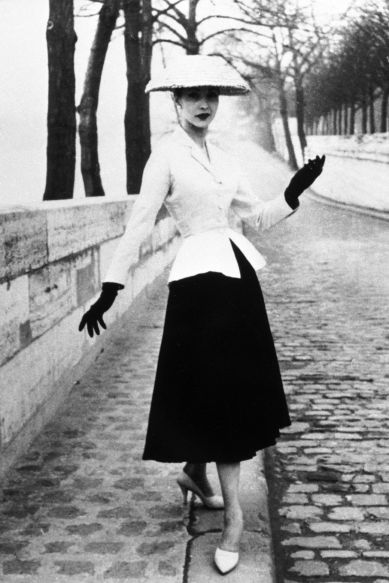
While the 1940’s were defined by bold, dark colors, the 1950’s brought back popping patterns. Whether it was stripes, polka-dots, or florals, patterned skirts were extremely popular worn with a solid-colored knit top. Often an embroidered design on the bottom part of the skirt appeared, which created the iconic poodle skirt look that we now associate with that time period.
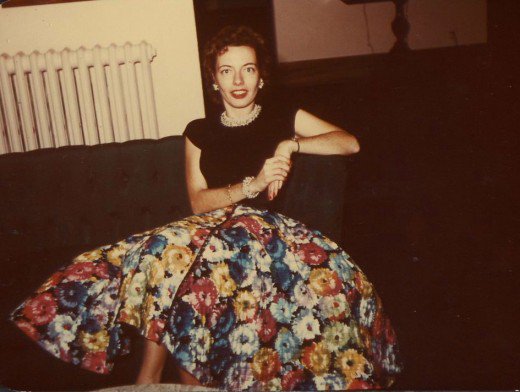
Labor day in Kansas still permits swimming in its hot weather, and 1950’s swimwear had a very well-known look. The one-piece, ruched halter or strapless swimsuit, often with a sweetheart neckline defined the fashion of the pools and beaches.
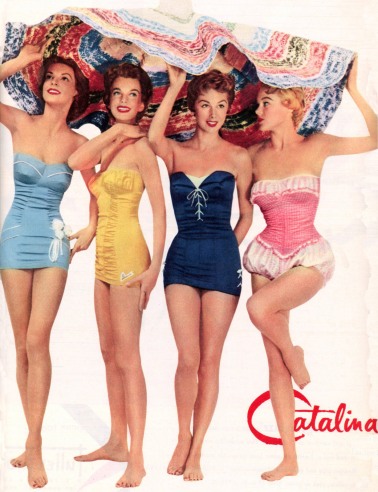
Accessories of the 50’s were simple but very common. The hat style shrunk from big, summery brims to smaller, often veiled styles. Glasses also became a popular fashion statement in the cat-eyed look with frames of varying colors. Gloves of both short and long lengths defined a woman’s outfit, for both indoor and outdoor situations. Pearls were the key jewelry. Short heels still were the highlight of dressier fashion, however more comfortable, casual shoes were also making their way into the spotlight. Espadrilles, sneakers, and the very popular saddle oxfords grew in popularity.
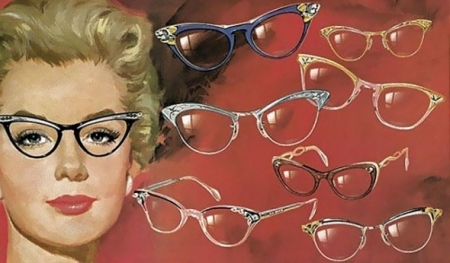
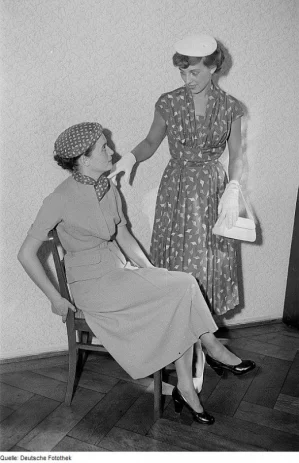
Thus, the 1950’s women’s fashion included cinched waists, big patterns, funky glasses, and saddle shoes, creating the look we all know and love to dress up in.
By: Madi Lang-Ree
Men’s Fashion in the 1950s
Although the 1950s saw a movement of women demanding more comfort and practicality from their clothes (the women having been introduced to clothes of the type when at the workplaces they were called into during WW2) fashion trends remained very strict and failure to conform to trends lead to an individual’s identity being judged as sketchy. This excerpt from The Artifice’s article “Masculinity, Gender Roles, and T.V. Shows from the 1950s” defines the source of the decade’s conformist fashion which stems from fear of disorder and rigidity in gender roles:
“The 1950s nuclear family emerged in the post WWII era, as Americans faced the imminent threat of destruction from their Cold War enemies. The ideal nuclear family turned inward, hoping to make their home front safe, even if the world was not. The image that we recall, largely as a result of the American television shows of the time period, is the picture perfect family consisting of the bread-winning, rule-making middle-class father, the doting housewife who was thrilled to wake up every single day and clean the house and cook all of the meals, and their children who never seemed to get into any sort of trouble that could not be fixed. During the 1950s, television gender roles were stricter and more rigid than they ever had been. The men put on their business suits every morning, went to their conforming jobs, became part of the American rat race, and then were expected to come home and be a father figure and a husband. These were oftentimes the same men that had fought on battlefields of WWII or the Korean War, and now their duties had changed, so that they had to fight Communism at home by being the perfect American man. “…now it is time to raise legitimate children, and make money, and dress properly, and be kind to one’s wife, and admire one’s boss, and learn not to worry, and think of oneself as what? That makes no difference, he thought – I’m just a man in a gray flannel suit” (Wilson 98). Recent scholarship in gender and psychology has addressed strict gender roles, and concluded that they influence the future behavior of children. During the 1950’s, it was of the utmost importance to socialize boys strictly as boys. Through these television shows, boys were shown how “real men” were supposed to act. These shows display clear differences between men and women, with women as subordinate. For boys in the 1950s, “being a man” and never doing anything that anyone could consider feminine was a lesson taught to them by their fathers and by the popular culture of the time.”
As you can tell, conformity was vital to being perceived as a good all-American citizen. Due to the necessity and eagerness of men to conform and portray the perfect, nationalistic masculinity, fashion for men was extremely definitive aesthetically and formulaic. The rest of this page will outline those trends that were considered attractive and proper for American men.
Let’s not let this culture contextual intro mislead you, reader, although a fear to stand out as unique struck most men of the 50s, their fashion is still cute as hell!! Overall, men’s fashion was flattering in its structure and silhouette and the decade’s interest in western and tropical (brought on by the time’s popular Western and Adventure TV shows) motifs brought a playfulness to the colors and patterns of the clothes! Look forward to seeing all these fashion traits throughout the page 😉
I should specify before breaking down the components of men’s fashion though that I will be looking at leisure wear exclusively here, as our play, Picnic, takes place on a Summer Holiday. Leisure wear is what men where seen in outside of the workplace. As soon as they came home from work, men would quickly change into another outfit that fit their evening’s activities. And whether that meant lounging, sporting or dining, men would always look drastically different in their leisure wear than in their work wear.
“What was different were the variety of colors and materials. For business, sport coat came in dark colors and small patterns like check and subtle plaid. For leisurewear the colors exploded into hunter green, burgundy red, slate blue, and charcoal grey in winter or bright blue, emerald green, silver grey, ivory, tan, teal blue and mustard yellow in summer.” “Solid colors were hardly ever just solid. They usually had subtle patterns of stripes, plaid or check. Others had rough textures of nubby tweed, blanket cloth or corduroy.” (Vintage Dancer)
We can see decisive textures and preppy colors in all clothing articles. let’s look further into each piece of an outfit now.
SHIRTS! ❤
We see plaid button downs – some of which mimicked western looks
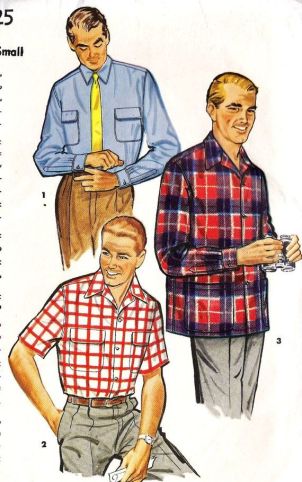
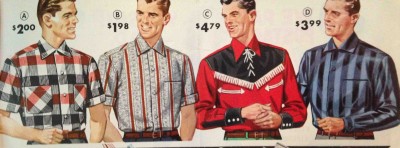
Casual Hawaiian shirts that could be left untucked
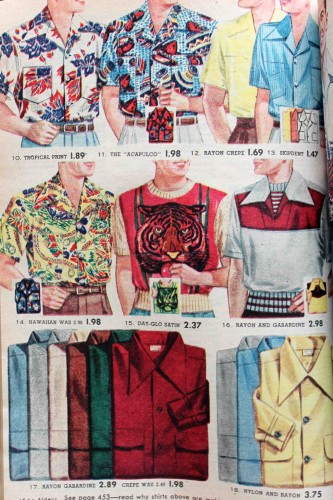
And knit shirts – most with a gathered waistband. A narrow, clean waist accomplished by gathering, cinching, and high waists was popular.
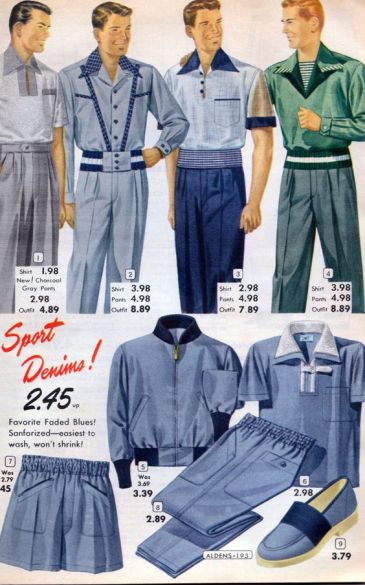
SLACKS!
Slacks were straight and slim. They had 1 single pleat running down the center of each leg to create an illusion of height and an element of elegance on a man’s figure. they sat just high on the torso, just below the ribcage.
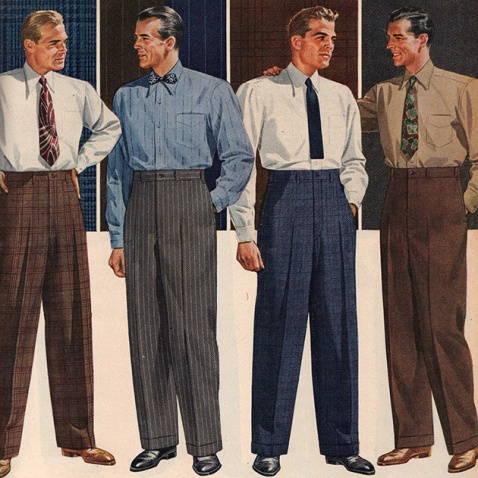
SHORTS!
Stylish men never overlooked the possibilities of a short! In the 40’s, shorts were only used for sport, but in the 50’s, preppy “Ivy League” added the article to their everyday. The longest shorts hit about 2 inches above the knee. Athletic shorts rose shorter.
“Don’t forget to wear them knee length so you don’t look like a fugitive from a baseball game. With them you’ll want knee-length socks in contrasting designs. The shoes of course should be moccasins or sports style. And wear these shorts with a swagger, lads. This is a fashion with the comfort men have been waiting for so long, and now,-in its many forms- it has entree anywhere.” Esquire, 1956 August
We even see men incorporating shorts into semi formal outfits, pairing them with sport coats, shirt and tie.
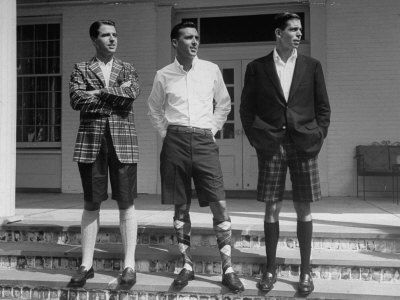
SWEATERS!
“Sweaters came in three weights: flat-knit was the lightest stitch, Shaker knit was a medium rib stitch and a shell stitch was thick and fancy. Most sweaters had ribbed necklines and wide rib cuffs. The fit was straight and slim just like jackets.” (Vintage Dancer)
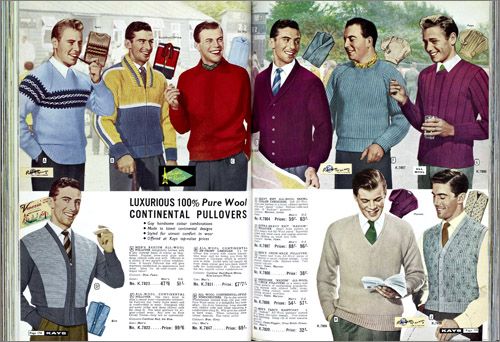
Makeup and Beauty in the 1950s
Makeup had its golden age during the 1950s. Unknown women became the face of cosmetic and beauty products, instead of well-known actors who had once been the only public faces of beauty. The everyday woman began wearing makeup regularly and it quickly became a beauty “must” for all women in 1950s America.
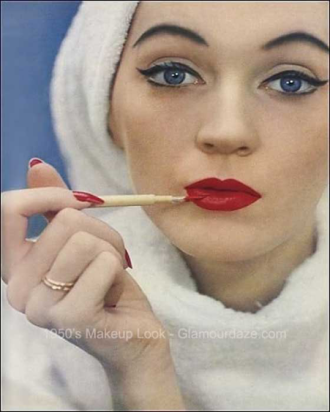
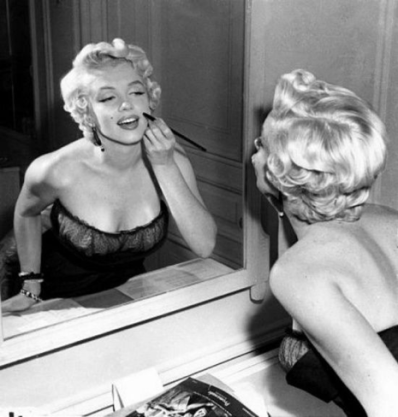
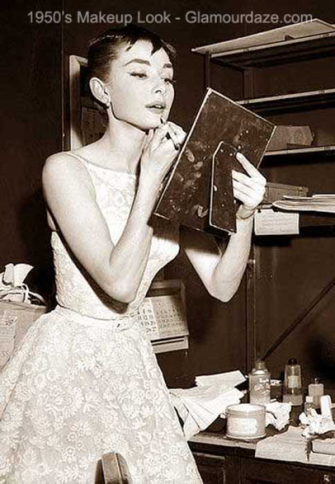
It is important to note that the standard of beauty was overwhelmingly white. All products made were for fair skin, and the lighter the skin, the lovelier and more feminine. Women took their beauty cues from icons like Audrey Hepburn, Grace Kelly and Marilyn Monroe; all beautiful white women. There was some makeup that was marketed to women of color, but the ads were often racist. In the 1940s, Madam C. J. Walker Manufacturing Company sold hair products and cosmetics to women of color, but the aim was to “lighten and brighten” the skin, maintaining a white standard of beauty. The ad below shows a woman literally wiping away her skin color to appear more beautiful.
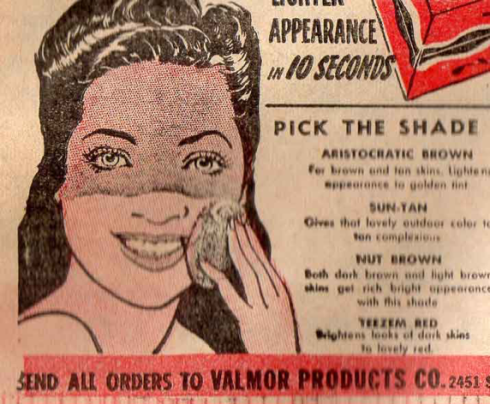
The classic 1950s makeup look was bold and elegant. Lip colors were dark and intense. Lips were important, but so were the eyes. Women woe eyeliner on the upper eye, mascara and sometimes colored eyeshadow. Eyebrows were also strong and defined. Often women wore them thin and arched.
Reds and corals were popular nail colors. Many adult women wore clear polish on their nails, but bright colors were very popular among teenagers. In Picnic, Millie asks Madge to use her manicure set, and she attempts to paint her nails.
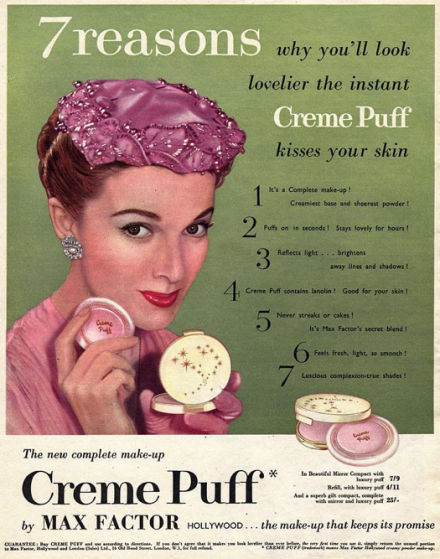
Bibliography
“Actress Grace Kelly Wearing 1950S-Style Makeup. The New Beauty Products of the 1950S Ushered in An..” Fashion, Costume, and Culture : Clothing, Headwear, Body Decorations, and Footwear through the Ages, 2013. EBSCOhost, libproxy.chapman.edu/login?url=http://search.ebscohost.com/login.aspx?direct=true&AuthType=ip,uid&db=edsgcc&AN=edsgcl.2760087282&site=eds-live.
“1950s.” Glamourdaze. N.p., n.d. Web. 25 Feb. 2017.
“Early ‘racist’ Marketing of Makeup toward Women of Color –.” Vintage Makeup Guide. N.p., n.d. Web. 25 Feb. 2017.
Team, AuthorH&MUA. “Women’s 1950s Makeup.” Hair and Makeup Artist Handbook. N.p., 17 May 2016. Web. 25 Feb. 2017.
Susannah, Walker. “4. Beauty Services Offered from Head to Toe: Promoting Beauty to African American Women in the 1940S and 1950S.” Style and Status : Selling Beauty to African American Women, 1920-1975, The University Press of Kentucky, 2007, p. 115.
By: Lena Romano



